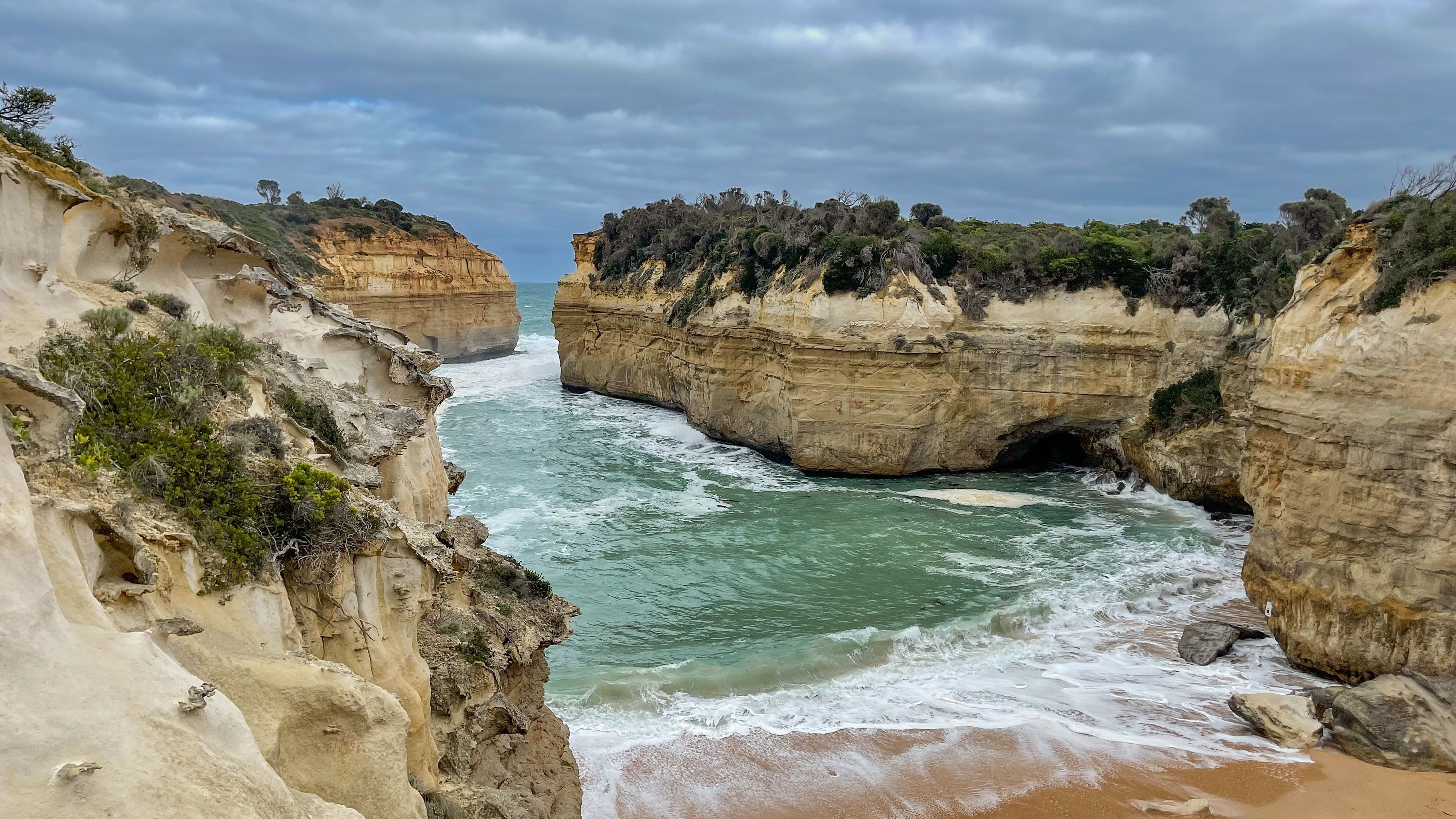
Loch Ard Gorge is the site of the most famous shipwreck on the aptly named Shipwreck Coast.
PHOTO BY AUTHOR
Water and wind are the world’s most skilful designers. There is nowhere I feel this sentiment more than while driving along the Great Ocean Road, a two-and-a-half-hour drive from Melbourne. On this coastal route, which has long been regarded by road trip aficionados as one of the world’s most scenic drives, Southern Ocean tides and ferocious wind sculpt the coastline. Following the contours of the land, the curving road plummets to the coast to access the beach. Moments later it winds up a cliff, that offers resplendent views over the Ocean and Bass Strait. The entire route is linked by towns that feel as if they’ve stepped out of the pages of a picture book.
But before I head on to this much-loved trip, I drive three hours from Melbourne to the Grampian National Park. A trinity of rugged mountains, cliffs and sheer rock faces that formed 400 million years ago, constitute a wonderland. While the Grampian Peak trail is a full 13-day experience, I opt for shorter trails over two days. Chance encounters with wallabies, emus, waterfall vistas and grandiloquent views are my rewards.
Two days of this adventure later, I drive two hours to Warrnambool. It is here for me that the tantalising spell of the Ocean Road is cast. The Merri Marine Sanctuary is a haven for colourful seaweed, fish, and crabs. Everything that thrives is backed by evolutionary reasoning. The dense carpet of seaweed “Neptune’s necklace” provides shelter from strong currents and enormous waves for sea creatures like crabs and sea stars. It also protects them from drying out at low tide when the rocks are exposed to the sun.
The Aboriginal history of these sites is as compelling. Research has it that the Gunditjmara aboriginal people, following the level of the tide, found sustenance in shellfish from different tidal zones. Empty shells, stone flakes and bone tools left behind give us an insight into how they lived.
Legs sore from exploration, Deep Blue Hot-Springs, a bathing sanctuary that harnesses geothermal, mineral-rich waters from deep within the earth, beckons. Detoxifying Sulphur, Magnesium for muscle health and Lithium for mood stabilising are some elements that constitute the salutary properties of the water. The natural temperatures range from 36-42 degrees, and I waft between pools. Those created in caves with waterfalls gushing overhead enhance silent contemplation. Others invite open basking. For those with more time to linger, the towns that link the Great Ocean Road have plenty to satisfy. Warrnambool, for instance, besides being known for the sightings of the Southern Right Whale, is also hailed for its galleries, and old churches. The Flagstaff Maritime Museum gives insight into the Shipwreck Coast’s dramatic history. My next stop is a 48-minute drive away. The Port Campbell National Park. Here Lock Ard Gorge is best known for the shipwreck of the clipper Lock Ard in 1878. But the geology is as compelling. The “Apostles” nearby, are temporary remnants of a retreating limestone coastline, born of a mix of sand and seashells, deposited in an ancient seabed, compressed millions of years ago. If you linger on the boardwalk around the Apostles, it is possible to witness cliff faces under constant attack by the wind and waves eating at the “apostles”, which are being eroded up to two centimetres a year. Change is life’s only constant.
For a grand overview of the area, it’s a good idea to take a scenic helicopter flight. From Port Campbell National Park through Apollo Bay to Lorne the beauty is especially heightened. Here pillars. There arches. Everywhere gorges and blowholes.
All permutations of choice exist along the way. I opt for instance to drive 45 minutes inland to see another unique eco-system. The Otway National Park with its southern temperate rainforest is home to Myrtle Beach trees. After a 25-minute walk on rugged bush track, I arrive at Lake Elizabeth, for a ride on a paddle boat. Staying silent as a mouse allows a possible chance encounter with the elusive platypus. In the end, the more time you offer the route for meaningful detours, the more it offers you.
Sometime later, I arrived at the memorial erected for soldiers who served in the First World War. I’m reminded of the fact that although the road has a mystical quality about it, nothing is instant or effortless. More than 3,000 ex-servicemen worked with shovel and pick, employing natural materials of the area to create what we now enjoy. Culture results in many remarkable things to applaud, the creation of this road among them; but in nature and in water, therein lies the sublime. Which is why its preservation is key. Tread lightly. Replace rocks if you move them. Revere the wildlife.
Getting there
♦ Most airlines offer excellent connectivity to Melbourne from all Indian metro cities.
♦ There are plenty of accommodation options that dot the way.
♦ To plan the route that works best for you, visit greatoceanroad.org.au